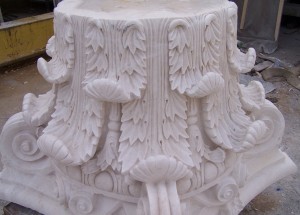
Stone art is an art form which develops according to the developments in the field of architecture and finds its priority usage area in architectural objects. From the point of view of the traditional Turkish arts, it is seen that the Great Seljuk architecture uses brick and a type of plaster which is called "stüko" as the main building material. Stone, on the other hand, is a material that is used not only in the building but also in interior and exterior decoration. Also, Küfeki and marble are the most preferred stone types.
Except for the general structure, examples of stone art for decoration and adornment are seen in the monumental entrances called "crown gate" which are located at the front of the buildings during the Anatolian Seljuks period. There are many extant examples of crown gates in Anatolia, that edge borders in various widths are usually adorned with geometric, floral motifs or text. The part above the entrance door is filled with spackle named "mukarnas" to give depth. In addition to the crown gates, ornamental samples are seen in the other constructions such as the walls of the palace, city walls, fountains and so on. In Anatolian Seljuks period ornamentals, lions, griffons, birds, eagles, snakes, angel figures, animal-human, animal-animal fights, rumi, palmet, hatayi and lotus motifs are the most used ones. Kufi and naskh are preferred as the font.
In addition to religious architectural works, the examples of the artistic quality of stone craftsmanship can be seen in civil and public architectural examples. The effects of Baroque art, which is dominated in Europe during the same period, are felt; alto-relievo which previously abandoned is used again to create a Baroque effect. The geometric and herbal adornment, which are classical Ottoman figures, also leave their place to girland, acanthus leaves, oyster shell, flower bouquet, flowers in vase in the Baroque. Among the most common examples of stone craftsmanship are the tombstones, mostly made of marble, which gain interest as a remarkable subject. Because of the tradition, the tombstones are made in separate designs for men and women, also involve shapes of imamah, kavuk or fez which indicates their qualities such as the profession of the owner or ancestry.
Another method of adornment mainly using stone is "mosaic". This arrangement technique is created by bringing together small pieces of one or more materials in different colors. Materials can also be glass, wood, and ceramics. In common use, colored or small pieces of glass or stone are buried in mortar and used to make floor or wall decoration.




